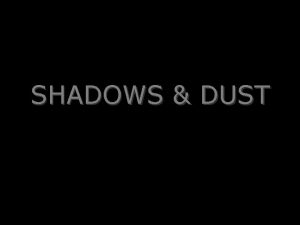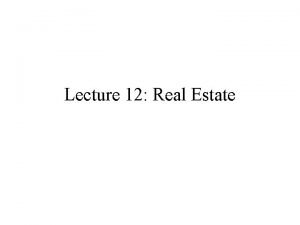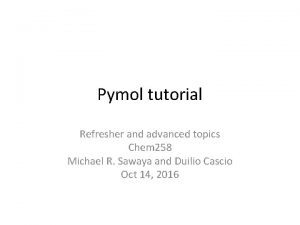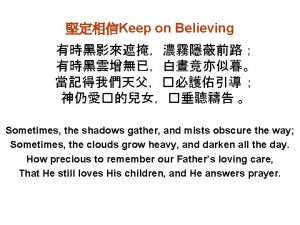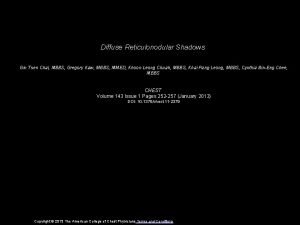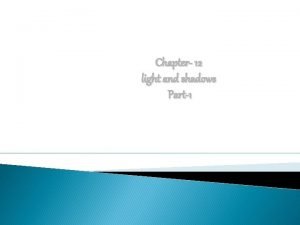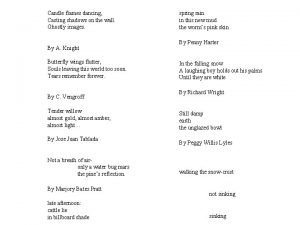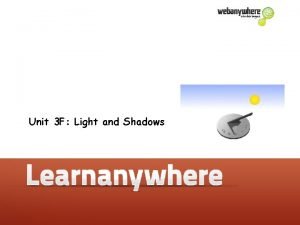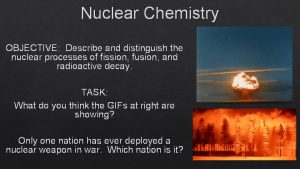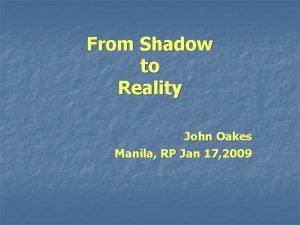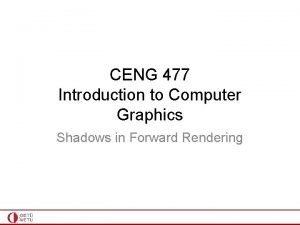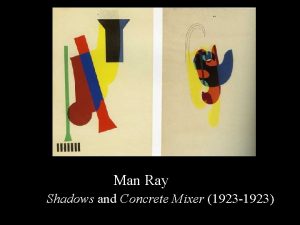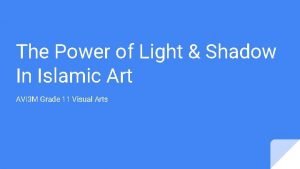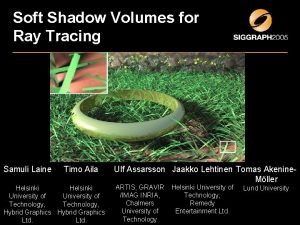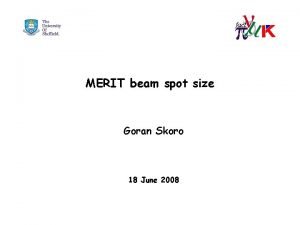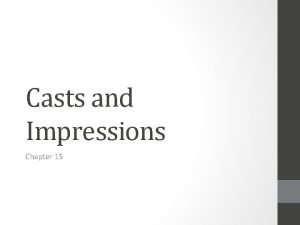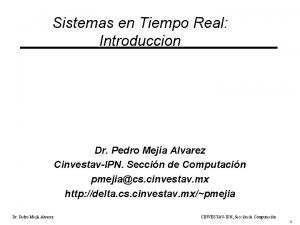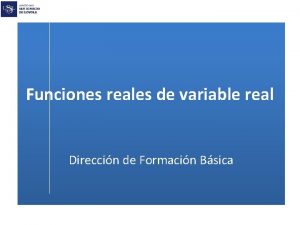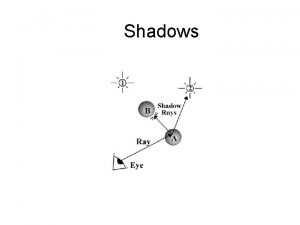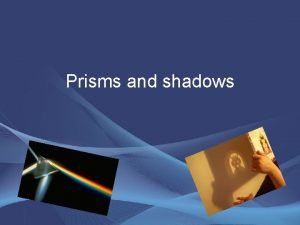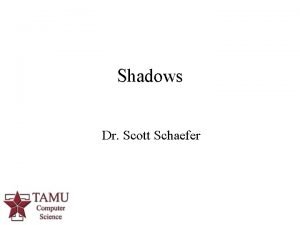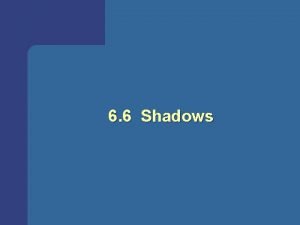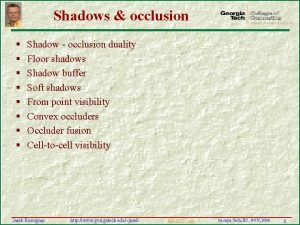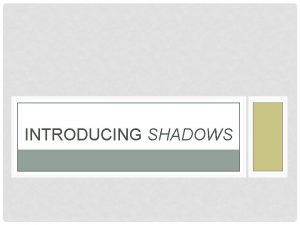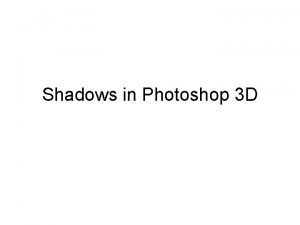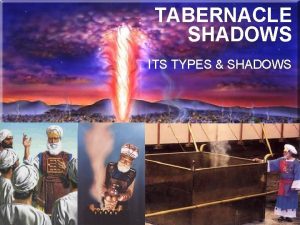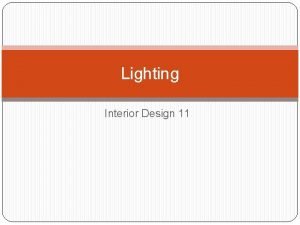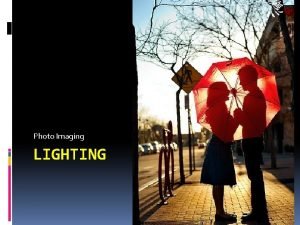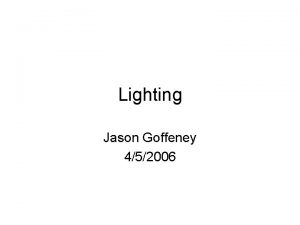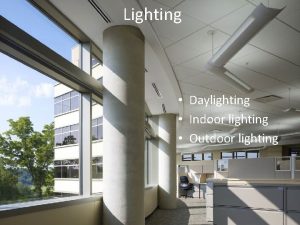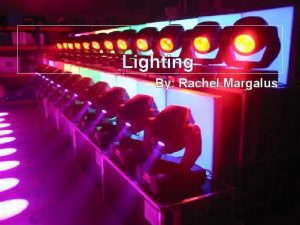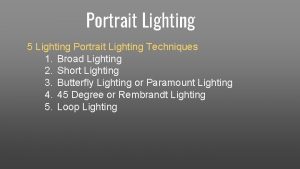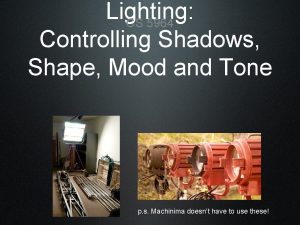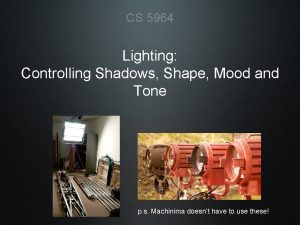Lighting and Shadows Lecture 7 Real Lighting is






























- Slides: 30

Lighting and Shadows Lecture 7

Real Lighting is expensive! • Factors: Lots of photons Complex interaction with surfaces Lots of bounces • Solution: approximate real-life lighting. Not at all the way real-life lighting works. • The big approximations Limit color values: [0… 255 or 0… 1] Simplify interaction between light and material. Diffuse: (or Lambertian or “matte illumination”) Specular: or Blinn or Phong or “hotspot” illumination Ambient or indirect illumination The “Standard Lighting Equation” • More advanced CG algorithms expand upon these

SIMPIFIED Virtual lighting (reflectance, absorbance, and perception) Emits a lot (1. 0) “Purple-ish” As a Vector: Emits None (0. 0) ~350 nm (purple) Reflects a lot (1. 0) Perceive a lot (1. 0) Light Source “Aqua-ish” As a Vector: ~800 nm (red) Perceives None (0. 0) ~350 nm (purple) ~800 nm (red) Perceived Color As a Vector: Reflects None (0. 0) ~350 nm (purple) 0. 6*0. 9=0. 54 0. 1*1. 0=0. 1 “Dark blue” “Material” ~800 nm (red) 0. 5*0. 1=0. 05

A new Vector. N function: Pair-wise product • The symbol your book uses is • For us: just to get the perceived color by pair-wise multiplying the light and material color. • No other interpretation (e. g. for “normal” vectors / points)

Specular Ambient Diffuse Example

Another Example. Lit Color Source: http: //en. wikipedia. org/wiki/Phong_shading

Just Ambient Just Specular Just Diffuse Everything

Virtual Lighting, First step: Lighting is dependent on: • The material properties (diffuse, specular-power [aka hardness, aka shininess], ambient color) • The light source (position, diffuse and specular color, and attenuation) Plus the number of lights. [For spot-light, we’ll also need a direction and angle(s)] • The curvature at the point of illumination • The camera

Curvature. Imagine an infinitely small plane at the hit point (the dotted line) which lies on the ground. The normal vector is perpendicular to this plane.

Normal Vectors, cont. • One option: use a modelling program # Blender v 2. 69 (sub 0) OBJ File: '‘ # www. blender. org mtllib monkey. mtl o Suzanne v 0. 437500 0. 164062 0. 765625 v -0. 437500 0. 164062 0. 765625 # 507 of these “v” lines vn 0. 671345 -0. 197092 0. 714459 vn -0. 671345 -0. 197092 0. 714459 # 507 “vn” lines usemtl None s off f 47//1 1//1 3//1 f 4//2 2//2 48//2 f 45//3 3//3 5//3 # 968 “F” lines

Normal Vectors, cont. • Another option: calculate it as needed. • The method depends on the renderable. N N P C P What’s the normal at P? A: Anywhere on the plane, the normal will be the plane’s normal! Not quite as easy here. The normal depends on where the hit point lies on the sphere. Hint: Use C and P to calculate N.

The STANDARD LIGHTING EQUATION!!! (10. 6) Note 1: We need to calculate a diffuse color and a specular color for each light. Note 2: We could have ambient “illumination” even with no light sources! Note 3: We could have lit colors over (1, 1, 1). So it is important that you clamp the result so that each component is in the range 0 -1.

Amb_c (Ambient Illumination) (10. 6. 4) • Remember: amb_c is based only upon: The overall ambient light in the scene The amount of ambient light the object reflects. • Said mathematically: is the color vector of the (scene’s) ambient light. is the color vector representing how much ambient light the material reflects.

Diff_c (Diffuse Illumination) •

c. Diff (Diffuse Illumination)

c. Diff (Diffuse Illumination) Observations: • P 2 should be the “brightest” • P 1 should be lit, but not as much as P 2. • P 3 shouldn’t be lit at all. So how do we do this? ? ?

c. Diff (Diffuse Illumination) L 3 Step 1: Calculate a direction from the hit point towards the light source (and normalize it) Q: Notice anything about the angle made by the normal vector and the light direction vector? L 1 A: Smaller angles == brighter illumination A 2: Cos(angle) is closer to 1. 0 L 2 Q: What vector operation can we use to calculate this? A: Dot product! N●L = cos(Θ) • This will be in the range -1… 1 (since N and L are normalized) • If N●L < 0, no diffuse illumination (so set it to 0)

c. Diff (Diffuse Illumination) • So… i. e. the cos of the angle between them If d. Str <= 0 If d. Str > 0 NOTE: You’ll need to repeat this for each light. The total diffuse light is the sum of the d. Color’s for each light.

Spec (Specular Illumination) (10. 6. 2) • Specular illumination tries to approximate the material-light interaction that are mirror-like. • In these, light that is bounced off the surface and hits the viewer’s eye will make it look as if that point were illuminated. • If the reflected light misses the viewer’s eye, there is no specular illumination.

c. Spec, cont. •

c. Spec, cont. Doesn’t hit the eye Points in this dotted area would have specular illumination. P 2 would be the brightest illumination of these.

LD: The (unit-length) direction from the hit. Pt to the light. R: The (unit-length) direction light would bounce off the surface (as in a mirror) V: The (unit-length) vector from the hit. Pt to the camera. c. Spec, cont. R 1 N 1 LD 1 V 1 LD 2 N 2 R 2 V 2 Note: The angle between v 1 and R 1 is big…there should be no specular here. The angle between v 2 and R 2 is small…there should be -of specular here.

c. Spec, cont. Now to calculate the specular strength… R 1 Q: What vector operation will give us a high (close to 1. 0) value for R 2&V 2, but a low value (0. 0) for R 1&V 1? A: Dot-product (just as we used N-dot- LD for the Diffuse calculations)! V 1 R 2 V 2

c. Spec, cont. Camera at (-5, 0, 15). White light. Sphere (pos=(0, 0, 0), diffuse=(1, 0, 0), spec=(1, 1, 1)) Problem: Notice how the specular highlight is very “spread out” – it’s almost like diffuse shading. This might be fine sometimes, but we’d also (sometimes) like a highlight like this:

c. Spec, cont. • Here’s a graph of specular. Strength as a function of θ, the angle made by V and R: cos 1. 2 1 1 0. 8 0. 2 0 0. 6 0. 4 0. 2 specular. Strength 0. 4 0. 6 specular. Strength 0. 8 specular. Strength 1 0. 6 cos 0. 4 0. 2 cos cos**2 cos**5 0 5 10 15 0 20 6 25 12 30 0 18 35 6 40 24 12 45 30 50 18 36 55 0 24 42 60 6 30 48 65 12 36 70 0 54 18 42 6 75 60 24 80 48 12 66 30 54 85 18 72 90 36 60 24 95 78 42 66 30 84100 48 72 36 90 54105 78 110 42 96 60 84115 48 102 66 90 54120 108 72125 96 60 114 78130 102 66 120 84 108 72 126 90 114 78 132 96 120 84 102 126 90 108 132 96 114 102 120 108 126 114 132 120 126 132 specular. Strength 1. 2 0 0 Degrees Degrees Cos(θ) (i. e. V-dot-R) falls off “gradually” as the angle increases (until it finally reaches 0 at θ=90). We want a “sharper” fall-off. How do we get it? A trick: Watch what happens if we square cos(θ)… …or raise it to larger powers… cos cos**2 cos**5 cos**10 cos**50

c. Spec, cont. • One final problem: How do we compute R (the reflected light direction)? We want to “mirror” LD (the direction towards the light) about N (the normal at the hit point). Note: This is "Phong" reflection. There are others (the book also has Blinn) Step 1: Compute LD||, the projection of LD onto N. S Step 2: Compute S, which is 2*Q Step 3: R is now S – LD (which is the same as S + (-LD) ) R LD|| -LD

Spec, cont. • So here’s our complete algorithm for calculating the specular illumination: If s. Str <= 0 Else NOTE: You’ll need to repeat this for each light. The total specular light is the sum of the s. Color’s for each light.

Shadows • Raytracer shadows are quite easy. • Algorithm: When lighting a point P… …If the light is blocked by another renderable, don’t add diffuse or specular illumination. …If it’s not blocked, illuminate it as normal.

Shadows, cont. P 2 Do diffuse and specular P 1 as normal. Don’t do diffuse or specular for this point (for this light) Does this look familiar?

Shadows, cont. • Sure it does! • We’re just casting a ray: Here the origin’s not the pixel plane, it’s a point we’re illuminating. The direction is towards the light. If we hit anything but the object the origin-point is on before hitting the light, don’t illuminate! • Hint: If you calculate the distance between the light and origin-point, the tvalues for any hits must be less than this value.
 01:640:244 lecture notes - lecture 15: plat, idah, farad
01:640:244 lecture notes - lecture 15: plat, idah, farad Shadows and dust meaning
Shadows and dust meaning Who made
Who made Real estate lecture
Real estate lecture Hiroko tanaka burnt shadows
Hiroko tanaka burnt shadows Reel shadows of the indignant desert birds
Reel shadows of the indignant desert birds Shadows are _______ in the evening than they are at midday.
Shadows are _______ in the evening than they are at midday. Pymol shadows
Pymol shadows How are shadows formed year 3
How are shadows formed year 3 Keep on believing god will answer prayer lyrics
Keep on believing god will answer prayer lyrics Shadows gin
Shadows gin Light and shadow chapter 12
Light and shadow chapter 12 Does flames have shadows
Does flames have shadows Pictures of shadows at different times of the day
Pictures of shadows at different times of the day Scary hiroshima shadows
Scary hiroshima shadows Who wrote the night of the scorpion
Who wrote the night of the scorpion From shadows to reality
From shadows to reality Pictures of shadows at different times of the day
Pictures of shadows at different times of the day Shadows in computer graphics
Shadows in computer graphics Man ray shadows
Man ray shadows How to make animals with hand shadow
How to make animals with hand shadow Samuli laine
Samuli laine Light shadows
Light shadows How do shadows change
How do shadows change Goran shadows
Goran shadows Types of impressions
Types of impressions Sensor and (tiempo real or real time)
Sensor and (tiempo real or real time) Variables reales ejemplos
Variables reales ejemplos The real real fashion copywriter
The real real fashion copywriter Polynomial in real life
Polynomial in real life Marketing: real people, real choices
Marketing: real people, real choices

